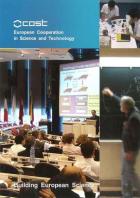
Methods for the Planning and Evaluation of Multiservice Telecommunication Networks - Final Report

Processing and Quality of Foods Vol 3

Air Pollution Effects on Terrestrial and Aqatic Ecosystems

MMSP'96 General Workshop- Proceedings

Self Pollinated Field Crops for Grain Use - Abstract Book WG2 Meeting

The Use of Geographic Information Systems in Climatology and Meteorology
- Pages: 245
- Author(s): OE. Tveito, M. Wegehenkel, F. van der Wel, H. Dobesch
- Publisher(s): Office for Official Publications of the European Communities
- http://bookshop.europa.eu/uri?target=EUB:NOTICE:QSNA23461:EN:HTML
- ISBN/ISSN: 978-92-898-0045-7
- EUR: 23461
The COST Action 719 has started in 2001 with18 European countries participating. There are manifold objectives of the Action, however, the main should be mentioned as follows: – establishing interfaces between GIS and meteorological data in close cooperation with the GIS industry; – assessing the availability, contents and accessibility of meteorological and climatologically data sets; * encouraging and fostering European co-operation in the development of operational applications of GIS in meteorology and climate research; * strengthening the links between the National Meteorological Services NMS), the research community as well GIS industry. Some of the expected benefits are: 1. better and more cost-effective production of state of the art meteorological and climatologically information, 2. improvement of the cooperation between European countries in the application of GIS in the field of meteorology, climatology and other environmental sciences 3. Better trained personnel within the operational and scientific divisions of NMSs.
The tasks are carried out within three working groups. Data access and data availability of all kind of GI data, monitoring the development in GIS technology and establishing the standardised interfaces between GIS and meteorological data is done by Working Group 1. The Working Group 2 covers the scientific program by its activity on spatial interpolation and Working Group 3 is developing recommendations for standardised GIS applications. In this area the applications have been already adopted focusing on three parameters, i.e. precipitation, temperature and energy balance. The three demo projects/case studies referring to the parameters have been formulated, namely: – Mapping the Precipitation Using Combined Information from Satellite Data, Mesoscale Forecast Models and Ground Measurements (Synoptic and Climatologic) – a GIS Approach – Spatialisation of Temperature in Alpine Regions – Energy Balance: Prediction of Road Surface Temperature Additionally, the tasks such as the development of a visualisation system for climate data sets for Internet application are under preparation. The presentation will provide the information concerning the work progress on demo projects made within COST 719.

The European COST Action B16 Symposium on Multidrug Resistance Reversal
- Pages: 45
- Author(s): I. Yalcin, E. Aki-Sener
Abstracts and Scientific Programme of the European COST Action B16 Symposium on Multidrug Resistance Reversal – 11th Management Committee and WG1, WG2, WG3, WG4 Meetings of COST B16 Workshop, which took place in Antalya, Türkiye on 13-14 May 2005.

Government Agencies –Practices and Lessons from 30 Countries
- Author(s): K. Verhoest, S. Van Thiel, G. Bouckaert and P. Laegreid (Eds)
- Publisher(s): Palgrave Mcmillan
- http://www.palgrave.com/products/title.aspx?pid=535098
- ISBN/ISSN: 978-0-230-35435-7
Why do governments create semi-autonomous public organizations, called ‘agencies’? How do agency types and their prevalence differ across countries and time? How are agencies controlled and held accountable? How autonomous are they? How have (post)-New Public Management ideas affected agencification policies in Europe and beyond? How do governments attempt to restore transparency and coordination in a fragmented agency landscape? And what can practitioners and policy makers learn from international experiences?
This volume describes and compare how semi-autonomous agencies are created and governed in 29 countries and the EU. It leads practitioners and researchers through the crowded world of agencies, describing the agency landscape, history and drivers, autonomy and control, as well as recent developments. It offers a rich empirical overview for researchers interested in comparing agencies in different countries, and for practitioners interested in agency practices and experiences. Evidence-based lessons and recommendations are formulated to improve agencification policies in post-NPM times. This is the first volume to cover all aspects of agencies and the phenomenon of agencification and will be an essential reference tool for policy makers and researchers.

